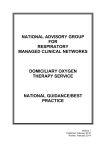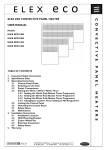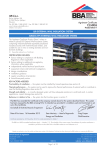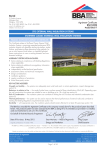Download Webinar Transcript
Transcript
Please note that this is a transcript of a live event. It is not well structured prose in Standard English or an academic paper. There may be paragraphs that do not make sense or words that are incorrect. There may even be errors that change the meaning intended by the presenter. Please consider these factors when using this transcript. If there is anything offensive or outrageously wrong, please feel free to contact us so we can correct it. Thank you for your understanding. Hello and welcome to CIC Start Online webinar today at Glasgow Caledonian University. My name is Branka and I will moderate today's event The project is funded by the European Regional Development Fund and Scottish Government through Scottish Funding Council This is a live event so in the event of a fire alarm will have to stop and then continue later. You can join as if you can, however we will be making a recording which will be available on our website in due course. Online viewers can use the online chat facility to ask questions at any time. There will be around 30 minutes for questions and answers at the end. If we run out of time we will forward your questions by email We now offer a live transcription service as part of our online broadcast. The presentation is transcribed live in a pop-up window as the webinar takes place. By providing the service we hope to make our webinars as accessible as possible. Instructions are provided in the log in e-mail that you have received this morning. So, today's seminar title is developing a template for Quick start user guides for a new home users Our speakers today are Matt Bradstock. Rosalie Menon from MEARU and Stuart Young of the home log book company I'll ask Matt to start with the presentation Good afternoon, I would you talk about the project that we worked on for the Quickstart user guide. So let's have a look at the methodology used in producing the test guide so, for my part presentation were going to look at the background. Before we undertook this project, the things that have been done by other people. Then look at some Scottish government research in collaboration with the Glasgow School of Art which incorporated the need for a quick start guide into the building regulations. The first stage was to look at the feedback including people from within the industry looking at how we develop a methodology and then go through one of the Quickstart guides and bring out some key issues and some key areas that we learned from Okay so the research background to this study - the Macintosh environmental architecture research unit is based on the Glasgow School of Art they have been doing at least 20 years of research into how buildings are occupied once the built, and the issues to do with reducing energy use, increasing efficiency and increasing comfortable indoor environment for homeowners in general do not have a great deal of information about how their house operates, and this is becoming worse by the range of technology that is being put into the new buildings Particularly new buildings heading towards the low carbon agenda with new types of heating systems, different things to do with airtightness and so on. BSRIA have developed a soft landings project for non-domestic buildings which helps people settle into buildings and learn all of the systems that are there they help users understand how they work - there is also the Usable Buildings Trust which is based in England but covers the whole of the UK, and they look at how buildings response to the occupants and how design and architecture can become better as people intuitively understand how to operate the buildings. So this background research fed into the work we have done and will present today. The need for these Quickstart guides was identified because; whereas 10 years ago a new home maybe had one or two different types of heating system depending on where they were, with new buildings there are many more systems such as ground source heat pumps, air source heat pumps, various different controllers, new controllers, a lot more control but a lot more buttons a lot more things to set they are also tied in with issues around airtightness and ventilation strategy which again adds a level of complexity The research Glasgow School of Art has been doing was finding that people had the equipment installed at the house but simply did not know how to use it for the optimal efficiency Like an ipod, out of the box you get an ipod a big thick user manual and a little one-page Quickstart guide which says basically you switch it on at the top you install some music and you play the music here - very simple. So we saw a need for this user guide which gives very quick instructions In 2010 that was incorporated into the building regulations gold and silver standard or optional currently within section 7 of the building regulations. The section about optimising performance and the quickstart guide is a mandatory part of that. So if you're trying to achieve a silver gold or platinum level within the building regulations, then you must produce a quickstart guide. The regulations say that you must produce a draft at application stage and a full version at the Inspectorate stage So taking that forward, to see how these guides can be used across a wide range of house types -this is Scottish governments building regulations guidance, you will see a couple of key points. It has to have a floor plan which is specific to the house and uses language that is able to convey technical information in a non-technical manner So the proposal was to build on the Scottish government research, investigate public and private projects, new projects, understand how to gather information, review the views of the residents, and then also the views of the developers on those templates The first one is Ogilvie homes they are designed in-house by Ogilvie 24 new houses of five house types. We chose the ones that met the most recent regulations, we also worked with the GHA (Glasgow Housing Association) - five house types with them. This guide is in addition to the eco-homes guide that was also produced This was architect-led project, which is quite important. So, we already had from the Scottish government a template and example booklet that we have proposed, so we try to follow those design guidelines as far as possible. But we also wanted to make sure that the home log book structure, it was easy for the development partners to give us information the front page also has the contents on it. This is the original Scottish government guidance. We modified these slightly from both the GHA and for Ogilvy in different ways. So heating and ventilation and hot water are all there they are common to all the booklets Sustainability, sustainability and energy features maintaining your home. Maintaining your home in the GHA one is more specific to the GHA as they have their own policies, and finally contact information so it is always to hand. The Ogilvy one, again heating ventilation and hot water all still there. Sustainability and accessibility as Ogilvy thought these were important from a design point of view. Maintaining your home has a slightly different focus for the homeowner. And some key contacts, particularly for places they can find out further information such as utilities companies and so want to ensure they had the best deal for their energy. The idea of these guides it's a small booklet which is meant to be kept in a kitchen drawer so it is always handy, that's one of the key things we wanted to have this handy it can be kept in the drawer. We did not want it to grow into a large A4 bulky document, and that's with the things about this template level of information is absolutely critical To have information that is too technical means that most people cannot get into it very easily, and if it is very simplistic and does not give you the answers then that is also a problem because people will ignore it, so trying to get the right level of information was the issue. One of the things we found from the Scottish government study was that the layout of the house is important that has to have all of these elements The water stopcock, electric meter and gas supply control they have to be in the right place. Trying to do one book for a range of house types, while things move about on the plan - the gas supply may come into the side of the house rather than the front. So working closely with the property company was very important. The other thing we felt was important was that very few people read plans. We used a threedimensional graphic to help people navigate their way around the house. Going through the booklet it was important to locate things. We also found that where there were particular issues, for example with sunspaces and heating systems it was really important to have a three-dimensional image so that people could orientate themselves correctly and easily. The first couple of pages are quite simply the layout of the house and identifying the key elements for the house. The second spread of pages was to tell people what their house was made of. Which was an important aspect for example timber frame installations, so much insulation windows are double glazed etc but actually to tell people the basic components of the walls the doors the roof the windows and the floors. Very straightforward, non-technical language but giving people enough information that they understand With things like the green deal and people upgrading and doing DIY. This is very important that people understand their starting point Perhaps knowing they don't have a masonry cavity wall is important, and this does have to be particular to this particular house. This is a slide taking the Glasgow house and showing the three-dimensional plan The three-dimensional plan is very important here because people could use some space at certain times of the day this made a difference to the comfort Special features really need this three-dimensional image to help the homeowner and Rosalie will come to that. With heating and hot water we had sketches or photos of the actual units that were in the house, and each of the heating systems is 2 pages - it says what the boiler is where the controls are and the thermostatic radiator valves tvrs etc Which ones you turn on and off at what particular time and how you control the heating. It has some dos and don'ts which help people and lean people towards having an efficient heating system. MEARU and the School of Art research shows that there are quite a lot of people who feel they have an energy efficient house, but have the heating on at the same time as having all the windows open in the winter, and therefore have a very inefficient house. So they have an efficient house with very high bills which gives a disconnect So, some very simple information some typical settings and enough technical back-up to enable people to make more educated decisions. One of the aspects of working with the home log book company is each were these guides comes with access to an online database of user guides, so that is really useful to be able to say it is all online and you can find out more details about the exact way of controlling that thermostat. But the book gives some typical settings to start off with. Ventilation Ventilation is one of the areas of significant concern to the School of Art in that we are finding that quite a lot of houses are properly ventilated, even with adequate ventilation according to the building regulations perhaps people don't understand how to use trickle vents or extraction fans. With the emergence of mechanical ventilation in homes this is key, even if is very straight forward it is important to have this information. Again dos and don'ts of ventilation, another important thing is the location of all of these things. Where is the trickle vent? Where is the boiler? It may not be obvious to many households. Particularly with things like mvhrs in the loft, is in the cupboard, is it hidden away? So, hot water this is a fairly straightforward A small diagram in the middle showing basically how it works, not a complicated schematic showing how the whole thing works, but just a bit is that people can understand. Just very simply what connects to what with locations. Quite a lot of systems are integrated with programmer so actually where is the hot water setting? Is it on the boiler or is on the programmer? What about solar panels on the roof etc? It can be quite a lot more complicated. We also provided information about the water companies and utility companies as a useful quick reference, not a detailed amount of information but quick reference With GHA they have the fuel adviser service, so this information was included. It gives information on how to reduce your fuel bills, maintaining your home depended on each individual house type. Obviously it took a great deal of advice from the developers and architects for which parts need to be updated For example MVHR, how often do you need to replace filters how often you need to clean it? And so on Very simple things but it starts to give people an understanding of which parts need to be replaced and how regularly And this is the Glasgow Housing Association contact, obviously Ogilvie have their own contact details here as well We issued these to a range of houses and Rosalie undertook a survey and got feedback on the booklets and she will talk us through this now Okay, Matt has talked us through the process of creating these bespoke guides the next stage was to test them in a live situation. The way that was done by distributing the guides to 2 different housing developments, One in the public sector through Glasgow Housing Association, And the other one being in the private sector with Ogilvie homes. And so with both of these developments, after the logbooks were issued we were able to distribute a little questionnaire Just to try and assess how effective these gates had been residents, whether it improved their understanding of how to use their homes more efficiently And the questionnaire targeted certain research questions. We looked at the timing and distribution of the home started guide. We asked some probing questions about their understanding of information when asked about their understanding of the heating and ventilation systems within their home and then any general comments on the success of the guide. So these guides were delivered either by post or by hand by the soaked agent or housing officer As Matt has already mentioned one of the developments was Ogilvie homes it was in Stirling, it had quite high end market detached homes, quite a lot of variations of the logbook, about 10. So each resident was getting a bespoke Guide which reflected their individual house layout to be distributed to 25 questionnaires, and 11 were returned But there are quite probing questions so feedback was quite detailed, likewise with GHA. They were very helpful in allowing face-to-face interviews too, which allowed for more personal comments and feedback over and above the questionnaire that had gone out. Again six different house types six bespoke home logbook variations As often is the case, a lot of the residents experience survey fatigue. So some of our responses on the postal side were not as extensive as hoped, but we did capture some feedback on those that we had returned. For many of the residents, English may not have been their first language so it was quite an interesting body to survey in that we were able to test the quality of the diagrams not just the English technical descriptions. So the results: One of the questions we asked was when they actually received the home started guide When they received the guide is actually quite critical Some of the information cannot be brought together until quite close to the handover date, but you also do not want to leave it too long after they move in- as it is a quick start guide after all, we want it in their hands within the first week of moving in. Some residents actually said the first day of moving in wasn't actually the best day as they had too much to do. Someone from the private sector had indicated it would be useful to have this Guide at the time of enquiry of purchase, as a given overview of the construction before purchase. There is a variety feedback here . The second question was who do you think is the best person to give you the quick start guide? Those answers varied significantly obviously in the social housing, say if the housing officer was the key contact, they are already showing them around the house, they had the relationship, so they should be giving them the guide The same in the private sector with the salesperson, the same with both cases was it should be somebody who had the time to explain it to them. One person for example had complained that the house layout was incorrect, however we believe it was the mistake of the person giving them the guide- but this raises an important point it is important to be the correct one, otherwise they dismiss it We then went to look at who had read the guide. Really everybody in the house who is in control or influences the heating should really be aware of the guide and read the key information within it. I think we all know that teenagers in houses have perhaps very different opinions to how the energy should be used, particularly with hot water and showers etc All the adults in the house should really have a look at the guide. Is it important to you to know how your house is built- of course we wouldn't buy a car without knowing the size of the engine or whether is a petrol or diesel. Should we know how houses built? Of course we should. 78% said yes it was important to them We believe residents take greater responsibility for the home if they understand how it is put together. We then went on and asked them more detail about how the guide was put together and how easy it was to understand Did floorplan layout help you to understand the location of controls? 72% answered yes those who answered negatively confirm that they had already located them prior to reading the guide. Feedback was that the book was clear - it wasn't cluttered . Many also commented that the floor plan was a very good way of understanding the location of elements within the house. This was especially the case with ventilation. Many residents had noted that they were not aware of what trickle vents were before they read the book, so was useful to have these located within a 3-D diagram as these may not always be picked up on a plan. Overall this is a fantastic result. 100% of respondents noted that the information was clear and easy to read And 100% noted that the diagrams are easy to understand Especially since some of surveys subjects did not necessarily understand English Some of the comments regarding the colour-coding of the sections which made it easy to understand the reference. The text itself was easy to read and not too technical, one person commented that maybe it was not technical enough. Others commented that the do's and don'ts boxes managed to condense information to very clear and concise instructions So then went on to ask more detailed information about the heating system Was that information specifically about the heating system easy to understand? 67% said that it was A lot of the negative responses here related to use of the timer, especially ones in the housing association block who said they had to seek additional instruction from neighbours or the housing officer. The purpose of this guide was more to give a point of reference to a manual rather than to provide overly technical instructions. Certainly, that was the one point of information which came up quite regularly. It is also an indication that we are living in a time where a lot of these technologies are maybe not as intuitive as they could be in terms of usability. Maybe there is an issue there that these could be streamlined into more of a standard approach, a broad approach as to how they operate. Whether any parts which were not clear? Again this raised some issues with technical devices such as timers, anything with buttons. The gains from Scottish building regulations state that these guides should not really going to high-level technical detail But generally people were satisfied with the diagrams and 3-D images of the house. A very general question at the end of the survey was “how helpful was the home start against overall?” And you can see 17% giving excellent and 72% providing good as a response. Some comments that came alongside that was that they were particularly glad to receive information on maintaining their home and giving more information on energy efficiency, And there was some good understanding that this was not a technical document it was more just broad guidelines and they were very welcome, especially with advice on energy efficiency. So where is the guide down where he put it? And of course some people couldn't find it where you put it? Many people kept referring to this thing called the blue guide. This must have been some kind of document that was provided with the house. But we really wanted people to keep this in a kitchen cupboard or drawer. It's a nice small compact size and we were quite happy to see the many people had kept it in a drawer or with other manuals. This is important to make sure the guide is passed from one tenants to another and social context. That was the outline of the questionnaire but what are we able to conclude from that? Well the timing of the distribution was quite critical The distribution of the guide should be done by someone who has knowledge of the house type, not anonymously or through the post. Additionally someone who has time to explain it to the occupant The guide should clearly direct residents the appropriate heating manual Heating issues controls programmers these issues kept arising throughout the questionnaire, so clarifying that to the resident this is not meant to be a technical guide but was to direct them to the manual Another comment was that the best book aged matched their individual house type And finally the guide should be kept in an accessible location and passed on to the next home owner or tenant. The guide should give simple and practical advice about maintaining aspects of the house which ensure energy efficiency, I guess this concludes where we are. Matt noted that this was important for new homes as there are many new technologies in housing. Really giving people the knowledge of how systems work in a broad principle of how they should be dealing with this addition of complex controls is really quite important and I guess another test to this pilot study would be to see whether the homeowner over the course of the year has used energy more efficiently than someone who has not received the guide. Of course, a lot of this is down to user habits and consumer behaviour Stuart from Home Log Book Company will talk about how the project has moved on to another phase We can give this information but we have to wait and see how much of this is absorbed into their habitual behaviour. I'll hand over to Stuart from the home log book company Thank you The home starter guides fits very well into a business This slide is really just to highlight how it fits into a product suite As properties become more complex through regulation and development, occupants need more information And need that information not in the first month or two but actually for the lifetime. We have seen that when people move into properties they are given large amounts of information. These are often bulky manuals which fulfil the needs of the housing association or new housebuilder, but we know from research is being carried out that tenants do not read these large manuals. So what we've done is have a look at how this information is given to people, most importantly what different media to be used. What we try and do is deliver information to people using the web, mobile phone, and digital TV. So what we're trying to do is deliver the content in a way that suits them in a very convenient manner. The home starter guide really is a key component of what we are doing. It fills a very big gap of when the time tenant moves in and until they have time to access information. In that initial period there is a lot going on and giving people handover manuals will overwhelm them and is not fit for purpose. We're seeing an increasing shift and change with some landlords and homebuyers who are really embracing this new media. This slide shows the relationship between people and properties. There is a lot going on around property and a lot of expectations of people in property - so what they can and can't do etc. Information comes from a variety of different sources. NHBC research showed that people were not given enough technical information about their property. They were given nice marketing information but not how to use it. Other feedback said that the technical information they did receive was far too complicated for them to be able to use it. And as Rosalie pointed out, the type of house becomes an issue as well As we can see it when someone moves into a property there is a lot going on around them about energy efficiency, managing the property, there are responsibilities, so we need to make it clear what someone should and should not do when they move into property and make it clear how that property should be managed. When you buy a car, there's quite clear ways to be serviced the car itself will tell you is due a service But with the house there is nothing like this, it is down to the occupant Working with GHA and Ogilvie, there are very common similarities with people moving into a property. From when they first moved in, the process of when the information is given is quite often the wrong time. People quite often wanted information prior to moving into the property and when they do move, their access to technology is often quite limited i.e. They don't have broadband yet. So is important that the quickstart guide is given to them within the first few days of moving into the property. This helps them get started, with the many products and services that are in their new house. As Matt said many products are using quickstart guides now and then you can read the manual later. The kind of manuals that people are given are too large and too much people to take in, and quite often technical information is hidden amongst other marketing information. The occupant was looking for something quite specific, it can be very frustrating trying to find that information The example of using this home starter guide across different areas. With Birmingham City Council were looking at 200 properties over the next few years. When people spend this amount of money on their properties they need to change the behaviour of the occupant in order to understand what has been done to that property so they can manage the property in the way that the property upgrades have been done The home starter guide really does lend itself to existing properties going through an upgrade process The other side is that we're working with Land Securities here in Glasgow have a lovely development on Buchanan Street. With this new build to want to put together a very quick simple quickstart guide. The home starter guide itself is quite flexible in terms of what you can put into it, as the new build is now three regulation are more complex with more and more technology and materials there is a greater onus of responsibility on order to learn how to manage and maintain the property So what we're trying to highlight here is that it does apply to new properties but also to existing stock as well. This all about when the information is given to someone and how it's given. It's about promoting behavioural change with this information being available online is more convenient for the occupants. They can access the information at their leisure So what’s the feedback we've had from the market? We started giving these guides to developers in England at the initial responses were incredibly positive. This can save as a lot of time and money as people are not reading large handover manuals. It's also quite attractive thing to give to new homeowners. Also was useful in training their own sales staff in the property. The first challenge was how the information is brought together, and who the responsibility of that lies with. If you think about other industries such as technologies and cars it is quite interesting to note it's not generally marketing people put this information together It is technical people to the home starter guide is meant to be a technical document In the current economic climate is important to get the right information into the home starter guide Sometimes small changes are made to the materials or features of a house at short notice, and this can make it difficult to keep the guides up-to-date and printed and delivered within the timescale so timing issues and they are quite important. So from our perspective overall it has been a fantastic project. And we thank Glasgow School of Art for helping us in terms of our understanding for not just understanding the initial moving in period, but also the whole lifetime of that occupant in that building. Thank you very much. We have time for some questions from our online viewers. While we are waiting for them to come in I have some questions of my own Have you done any work on existing property stock? You're right this is a very good point. It's easier to generate a guide for a new home when there is a clear entry point But with existing stock often there is very poor information about what it's already in place So is about good quality information Was also an issue with traditional buildings in that they were intended to be occupied in a certain way, for example Glasgow tenements. There are intended to have a fire burning in each room to keep the whole building warm so making a large change like a new central heating system Actually changes the way that people use that property The current owners will need that information but also the next owners and the owners after that would need the information. Here's a question from Gary Mees Whilst I understand this document is dealing mainly with sustainability do you see this document encompassing health and safety issues, for example smoke detectors and means of escape and maintenance thereof? Any thoughts on ensuring these documents are current when alterations made and who would be responsible? The starting point of this was that this research that we did. The Scottish government was about sustainability, it had quite a discussion with Scottish government about how we incorporate health and safety as part of this. Things like fire exits were integrated into the design level and legislated as part of design but my feeling is at the right level this information could be incorporated into the book. There are pros and cons Pros obviously there is more information. The con is obviously the aim of this book is to be thin and readable, if you add more pages to cover more and more aspects of the property could detract from the original aim of the leaflet, So keeping as a short easy read and referring people to other places is more important. I think Matt is right, at a very practical level, this is a quick start guide And I know we had feedback from one housebuilder that the felt this guide was too simple for their customers But it arises that people just want a quick start guide and if you make this too large to wide to fit that it will actually put people off and less likely that they will read it. So this book should re-point to that in-depth information that they can read at a later stage. Question from John Stinson Was a quick guide was each has fitted with direct easy release adhesive labels? Section 7 gold aspect five In these plans we did concentrate on 3-D models locations of controls We did some work with a booklet to make it applicable for buildings where the stickers had not yet been applied Generally stickers is a practical issue and an aesthetic issue. Would you have stickers all over your car? In terms of some of the feedback, the problems were that people could not actually take some of these things, never mind a sticker And at the downturn in 2008 which have a serious impact had look at different sectors and in 2011 we did a huge shift and soft looking at existing housing stock And we started working with housing associations, social landlords, looking at how they manage the properties especially looking over a 30 year period we saw this as an opportunity to communicate information to their tenants I think in many terms in Australia the market is more advanced than ours when looking at renewable energy sources and sustainability. The potential for this really is that it does not matter where your property is or what kind of property you are talking How many homeowners currently use the system you provide? Looking at the relationship between the press and the property, that relationship changes over the time that they live in the property. We need to keep information in the book updated, and make the information available to them in different media that can be changed as the property changes Another question how do you assess the impact of the service you provide? Various ways of doing this for example we look at the complaints to developers NHBC research highlighted that homeowners are usually unaware of what kind of information they should be receiving, the information only becomes available once a problem occurs. So we monitor this by looking at reduced callbacks when people have information. Looking at better energy management of the property, we can monitor this with smart metering. For example were doing one of the largest projects of this kind in Scotland We can look at people's more prudent use of energy so we can manage that Improving reactive and planned maintenance in the social sector And it's very much about behavioural change of the occupant of that property, Knowing how to use that property. So a few technologies introduced into the building and it does not behave as expected, we have to look at this. Is it due to a technical failure or is it due to poor operation on the part of the tenant? So an architect is spending a great deal of money on upgrading property stock need to make sure that the editors are realised by the occupants So there are a variety of different ways of measuring success There are a couple of views Either the building has been designed in a way that the occupier cannot use without the information so you have to give them the information, Or as the designers preparing this information then they have to think about how that occupant will use this property So this is a property improved because somebody has gone through identified areas that are a problem So looking at timers and programmers and controllers for example there are very few that people can just use. Rosalies' figures on the feedback just goes to show that controls are a problem Perhaps we should be changing controllers for ones are easier for people to understand intuitively Another question now again from John Stenson I'd like to know the speaker’s opinion on including the EPC as part of the quickstart guide So this is the energy performance certificate There has been a long discussion between ourselves and different developers certainly with Scottish government. My own personal view is that part of information as part of the house and it should be there somewhere however there are other views, particularly about the reliability of EPC, so if you compare electricity bill to your EPC then you can see your house is not performing. My own personal view is that it would be useful. In answer to your question the EPC is an important part of the property But how important is it in a home starter guide? Is often used as part of the marketing literature And this goes back to the question what is the purpose of the home starter guide. The EPC can be stored alongside logbook which can be reviewed a later stage, but the idea of the quickstart guide is to make people familiar with the features of the property and efficient way I don’t want to be negative about the EPC is just about the appropriateness of it in this book . Another question now from Gloria Lo I agree that the guide should be kept simple, however I wonder of the maintenance checklist could include other aspects that need regular attention, for example painting timber or clearing gutters etc without making the book too much thicker? We spent a lot of time with Ogilvie homes debating what kind of maintenance information should be given to the occupants and the problem there is that we do not know who we're dealing with - we do not know the occupants ability. And unfortunately one of the issues here was health and safety for example if we tell somebody to clear the gutters is this the right information to give them we do not know their ability and the gutters could be two stories up? I think there’s a long debate to be had about what is included in the maintenance, and Glasgow Housing Association would have very different advice compared to private homeowners. I think it is certainly a key part of the guide but as to what exactly what it contains, there is much discussion Gutters is an excellent example is down to the individual building type but also down to the ability of the individual. Another important aspect with a lot of these new technologies, particularly with MVHR systems if the filters are not replaced, then the systems are not working at all Some by some notes about what needs done and by whom and what time should be considered Would you consider perhaps sending an e-mail from home logbook company to alert as to what it's done? When the social housing sector the region not want tenants to carry out maintenance, they have planned maintenance programmes In the private housing sector, yes there is an opportunity there to provide information on maintenance and I did have timescale and what it's done Technologies and products was in the home have warranties but these warranties specify maintenance. So the tenant or homeowner has to be made aware of their obligations, for example changing filters ,or central heating boiler which needs to be serviced on annual basis. As an example the maintenance stated in the GHA guide was simple Check the smoke alarm every week Clean the smoke alarm every month, using the vacuum cleaner, so smoke alarms yes they can be responsible for Here is another question from John Stenson Taking up the point of persistent effect and behaviour change is it essential that the quickstart guide is accompanied by real-time energy monitoring to use language like pounds per day etc This is quite interesting we have been doing a lot of work on monitors An in-house display can work well with this, however we offend the people quickly become disinterested disease and the become a waste of time So using the web or mobile phone apps or digital TV can keep the occupant engaged So if we can deliver this information through the right channels that will have an impact Different people treat their homes in different ways and is very difficult to the standard approach. The people are watching a different times have showers are different times is very difficult to compare like-for-like. There is also slightly wider issue here it impacts on post-occupancy evaluation and impact on the EPC discussion Both occupants answered in a survey that they are very efficient energy users, however when comparing actual results, one occupant used 2.5 times as much energy as their neighbour. So this is a big question what is the benchmark for this house normally? So this is the big question what is the normal use in this house and how do we define normal? Another problem with meters like this is that there is no call to action, there is no follow up, it just tells you how much energy you are using So we use this analogy that the car – it tells as we're doing 40 miles an hour yet we are still driving when it should be 30 mph Okay we don't have any more questions from our online viewers but could you tell us anything about the project in terms of a conclusion or other ways forward more study or research is required? Yes, I'm going to work at Glasgow School of Art were doing a lot of building performance evaluation and identifying issues relating to behaviour. We see this is a really good stepping stone and essential, as more technologies are introduced in new homes We’re currently dealing with optional standards, but if we were to go another step in the regulation and these were to become mandatory then we really need to have something in place educates and informs the owner Something simple short and effective and well communicated really has a place for a commercial perspective what MEARU It was great for us I even spoke this morning to Ogilvie and they were very positive There is some need for them to change their processes and procedures a little bit and to include this guide as part of their handover process would offer a huge long-term benefit So I hope over time this will evolve in many different ways Thank you very much for your presentations and thank you to our online viewers are asking questions Thank you very much for watching a webinar







































